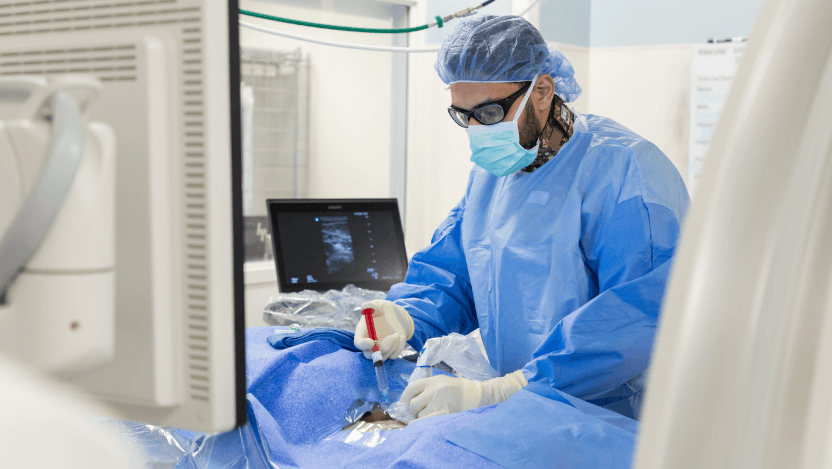An alternative to knee replacement surgery? NIH-funded study is testing a procedure for osteoarthritis knee pain

Interventional radiologist performs a genicular artery embolization surgery on a patient at the University of Chicago Medical Center in Hyde Park.
People with osteoarthritis in their knees can try several different treatments to conquer the pain, swelling and stiffness that accompany this degenerative disease.
Pain medications, steroid injections, physical therapy and nerve ablation can provide relief, but some patients eventually require surgery to replace the damaged cartilage and bone in their knee.
The University of Chicago Medicine began a pilot study in 2022 on genicular artery embolization (GAE), a unique treatment designed to delay or even prevent knee replacement surgery. The procedure works by sealing off problematic arteries that grow into the knee joint, causing inflammation or compression.
Through this study, UChicago Medicine became the first hospital in the Midwest — and among the first in the country — to offer GAE. In the past two years, UChicago Medicine doctors have performed more than 100 of these procedures with overwhelmingly positive outcomes.
Thanks to a September 2024 grant from the National Institutes of Health UChicago Medicine will continue studying whether GAE relieves knee pain.
What is knee osteoarthritis?
An estimated 5 million people suffer from knee osteoarthritis. It happens when protective cartilage in the joint wears away. The pain can become severe if there is no cartilage left and the bones essentially rub against each other.
“Patients can experience shooting pain every single time they put weight on that knee, which is basically every step they take,” said Magdalena Anitescu, MD, PhD, a UChicago Medicine interventional pain medicine specialist and anesthesiologist who served as co-investigator on the pilot study.
But when nonsurgical treatments fail, many patients aren't ready for knee surgery. Patients who are on dialysis or who have severe obesity or poorly controlled diabetes may not be eligible for knee replacement surgery.
“Knee replacement is a wonderful procedure that can give people their life back and allow them to get back to doing activities they weren’t able to do,” said UChicago Medicine orthopaedic surgeon Tessa Balach, MD, who specializes in knee replacement surgery. “But I think GAE may be a great option for those who aren’t ready for a knee replacement yet, and this is not a small group.”
How does GAE work?
Embolization — the blocking of blood vessels — has been used for decades to cut off the blood supply to tumors and to stop internal bleeding, including in the knee.
Now, with GAE, a doctor uses an X-ray to guide a tube less than 1 millimeter in diameter into the arteries of the knee, injecting dye to determine which arteries are abnormal. A temporary agent of oil and dye is then injected to block those specific vessels.
The inflammation drives nerve growth and pain in the knee area. If the process of blood vessel growth and inflammation is reversed, then the pain can also be reversed.
Patients are lightly sedated for the procedure, and there is a risk of bleeding and infection, as well as temporary skin discoloration and pain afterward.
Researchers are still working to confirm how long the results of GAE treatment lasts; early data suggests at least one year. Ongoing studies are also designed to make sure there is no placebo effect associated with the treatment.
There are multiple GAE studies underway at UChicago Medicine — a multidisciplinary effort by doctors in the Departments of Radiology, Anesthesia and Critical Care, and Orthopaedic Surgery and Rehabilitation Medicine.
To learn more about GAE and the clinical trial, click here.

Magdalena Anitescu, MD, PhD
Magdalena Anitescu, MD, PhD, is a leader in the field of anesthesia and interventional pain medicine.
Read more about Dr. Anitescu
Tessa Balach, MD
As an orthopaedic oncologist, Tessa Balach, MD, provides comprehensive surgical care for bone and soft tissue tumors.
Learn more about Dr. Balach